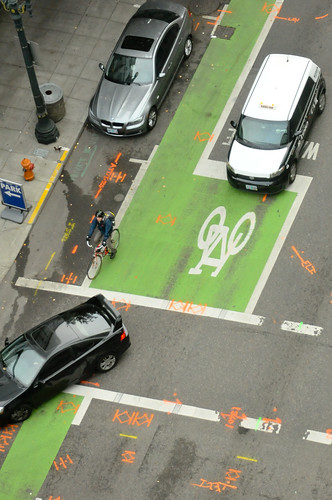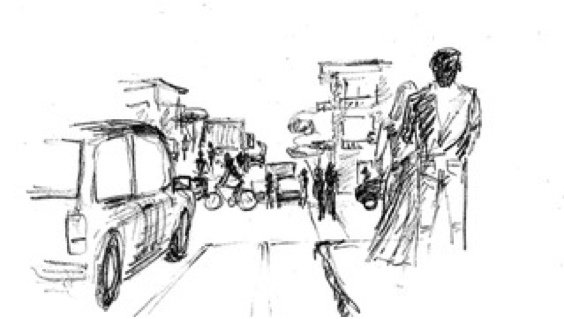
A near-right hook on Southwest Broadway.
(Photo: J. Maus/BikePortland)
This article was written by BP Subscriber John Liu.
This is the first of a series of planned Subscriber Posts on how to ride a bicycle defensively in the imperfect city.
Why read this post?
This post is meant to share riding skills for people who want to take extra precautions against drivers who are distracted, careless, aggressive, inexperienced, or simply fallible humans. And for responsible drivers who don’t ever want to hurt or kill a bicycle rider due to their driving.
Drivers of box trucks, delivery vans, semi-trailers, heavily loaded pickup trucks, or RVs are completely dependent on mirrors, with no ability to look over their shoulders. Sometimes the view through those mirrors is quite limited.
Don’t read this post if you want to know a bicycle user’s legal responsibilities, or if you want to know what cycling should be like in a perfect, Copenhagen-ized city. As bicycle operators, we can ignore everything I write about here, and we may still be legally “in the right”. And dead.
About me: 40+ years of riding bikes in cities, 30+ years of driving in cities, 10 years year-round bike commuting in Portland, licensed driver with motorcycle endorsement, and zero bicycle-car accidents ever, as either a bicycle or auto user.
What is a right hook?
A right hook is when the driver of a car or truck makes a right-hand turn and “cuts off” a bicycle user who is riding on the vehicle’s right-hand side. In the typical right hook, the vehicle is making a right-hand turn from the curbside traffic lane at an intersection, while the bicycle rider is attempting to travel straight through the intersection in a curbside bike lane. The bicycle rider may hit the vehicle’s right side, or be run down by the vehicle’s rear wheels, or both.
Why do right hooks happen?
This is a common crash type because there are so many reasons it can happen.
The driver, when turning right from the curbside traffic lane, may be looking forward for pedestrians in the crosswalk, but fail to look behind for a bicycle. This can be due to carelessness or poor training. The intersection may be so busy that the driver’s attention becomes overloaded. Or the driver may come from a place where there are very few bicycle riders on the streets. (I’m talking to you, Texas and Arizona.)
The driver may check his passenger side mirror, but fail to turn his head and look over his shoulder for a bicycle in the mirror’s “blind spot”. Drivers of box trucks, delivery vans, semi-trailers, heavily loaded pickup trucks, or RVs are completely dependent on mirrors, with no ability to look over their shoulders. Sometimes the view through those mirrors is quite limited.
The driver may check behind, see a bicycle at what seems to the driver like a “safe” distance behind, and make his turn without reaizing that the bicycle rider is moving much faster than he/she expected. This might be the case if the road is downhill or the person is a fast rider sprinting for a traffic light.
It may be dark and/or raining and/or the bicycle may not have a headlight, so that the driver does not see the bicycle rider despite looking behind them.
Advertisement
How riders can protect against right hooks

(Sketch by John Liu)
The basic precaution is to avoid riding near or next to the right-hand side of vehicle that is approaching an intersection. If you’re not in the right hook danger-zone, you can’t get hooked.
If approaching the intersection alongside or just behind an auto user that is also approaching the intersection at a similar speed, the Defensive Rider will slow down to let the vehicle get safely ahead. If the vehicle operator turns right, the rider has given himself room to brake or swerve.
Some of my steel-legged readers will have the alternative of sprinting hard to enter the intersection well ahead of the car. I suppose this falls under “the best defense is a good offense” sort of tactic.
If the rider is approaching the intersection and the person in the car ahead of them is slowing or stopped at the intersection, the Defensive Rider will also slow or even stop, until he figures out the driver’s intentions. A driver who is slowing at an intersection is often preparing to turn, and a driver stopped at an intersection if often about about to turn. Remember that drivers may turn “right on red”.
It should go without saying that a right turn signal, a driver’s head turning to the right, a front wheel starting to steer, or a car moving over to hug the bike lane, are all signs for the Defensive Rider to brake or swerve. Especially if the vehicle wears license plates from a state where there aren’t many bicycles on the road.
Brake, or swerve? Usually, the Defensive Rider who sees a right hook developing ahead will have plenty of time to brake. I don’t recommend making a hard right turn inside the vehicle’s turn, as much fun as that sort of two-wheeled dogfighting may be. For one thing, you’ll probably eat the rear bumper of the car parked around the corner. The “best defense is a good offense” sort of rider may choose to swerve hard left and sprint around the vehicle on the driver’s side, mouthing expletives that I’m sure we are all too well-bred to speak audibly. Good luck with making a regular practice of that…
Wait, you say, as the rider in the marked bike lane, “I have the legal right-of-way, so drivers have to wait until I’m safely past before turning!” That’s true, and your estate’s lawyer will be happy about it.
How auto users can protect against right hooks

(Sketch by John Liu)
Before turning right, the Responsible Driver will turn on their right turn signal and make absolutely sure there is no one riding a bicycle to their right or following closely to their right rear. That means checking over their right shoulder like we were taught in driving school, not just glancing at the passenger mirror. Mirrors have blind spots.
If driving a truck or other vehicle that doesn’t permit looking over his right shoulder, the Responsible Driver will check his mirror very carefully and make the turn very slowly.
If driving a semi-trailer or other vehicle that has mirrors with limited rear visibility, the Responsible Driver will come to a complete stop before slooowly making the turn.
If all this seems confusing because you learned to drive in a state where there aren’t bike lanes or bicycles, then re-learn. You’re in Oregon now. No excuses.
Variations on the right hook
Drivers don’t turn right only at intersections. They also turn into driveways, parking lots, fast food drive-ins, and sometimes dive nose-first into parking spaces. The Defensive Rider will learn which driveways on his daily route act like car magnets, and treat them like intersections.
On rare occasions, a driver in a lane far from the curb will suddenly whip into an utterly illegal right turn, crossing the cubside lane and the bike lane. Being so unusual, this is very hard for even a Defensive Rider to predict. This is where the state of your karma is important. If you survive, buy a lottery ticket.
We haven’t discussed the situation when someone who is riding in the curbside lane, squeezing between moving vehicles and parked cars, gets right hooked. Suffice it to say, the Defensive Rider does not condone “lane-splitting”. He may have done it himself on occasion, but there’s no proof and anyway he’s not going to tell you how to ride like that.
Oh, and, bicycle riders can also right hook other bicycle riders.
Cyclists don’t want to be any closer to the car than is shown, and hanging further back is better. If that car is slowing or stopped, watch out! Drivers, we know the intersection is busy and you’re trying to keep track of all the cars, pedestrians, bikes, and traffic lights ahead of you, but you cannot make that turn until you’ve checked what is behind your right shoulder.
Okay, that’s what I have to say. Any other Defensive Riders want to chime in? How do you stay safe on the imperfect streets where we live?
— John Liu, BikePortland Subscriber (Want the ability to post stories? Support BP and join our community today.)
Never miss a story. Sign-up for the daily BP Headlines email.

